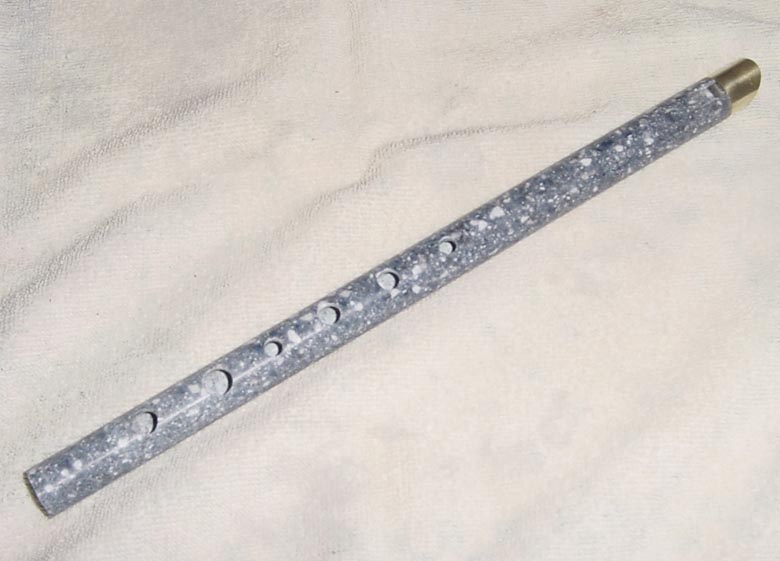And before Gasbandit asks...
Yes, I've eaten a hairy sausage
Yes, I've eaten a hairy sausage


And before Gasbandit asks...
Yes, I've eaten a hairy sausage


1) So, I like doing crafty things. Cooking falls under that. A couple years after I started playing whistles, I discovered the handmade whistle community. There's a whole different world out there beyond the $5.00 Generation brand whistles you find at many music stores. So I've always been fascinated by it. One day, I sold 3 or 4 handmade whistles (some of which can go for between $600-1000) to fund my adventure in making them.If I recall, at one point, you mentioned you've made whistles in the past? Tell me more about that.
What is it about cooking you most enjoy - the process, or the results, or something else? Why?
What do you do to motivate yourself when you have a task you need to do but don't want to do?

1) I read music, but not well enough to sight read while playing. Written Irish music is just a barebones representation of a piece anyway. It gives you the basic notes, but doesn't convey any of the flavor, nuance, or swing of a tune. So I use sheet music to learn the barebones, and then I listen to good players to understand how the tune is supposed to really be played.Can you read music or do you learn your tunes by listening?
What other instruments do you play?
If one were to visit D.C., where would you suggest they stay, and how to get about?
What is your favorite cuisine?
Do all of your exes live in Texas?
Last time I did an AMA when everyone else was doing one, and I didn't get much love. I figured if I started one when people weren't burnt out on the idea, I might get some real questions instead of "which would you rather fight..a horse sized duck, or 100 duck sized horses."So, what's with not wanting to be on the bandwagon? You think a tinwhistle's a solo instrument?
Well, as i mentioned, the gun drill is self-centering, so there was very little wander. I read that you could also use a lamp auger, but a gun drill polishes the bore as it drills, saving me an additional step. The drill I had made was a custom job with geometry made to cut wood, and an additional MT2 taper added to it so that it would fit on the wood lathe. It cost more than the drill press just for the drill bit.Interesting! I hadn't considered it, but those whistles do have a low diameter to length ratio. I've never used a gun drill, and am surprised you had good results on the wood lathe. I assume you drilled the stock completely through, then used the internal bore as your center for the machining lathe? That would eliminate an imprecision introduced by the wood lathe, though perhaps the whistles don't need more precision than the wood lathe provides - I just assume they do since you chose to get a machining lathe as well.
Larger lathes are more expensive...but I read bad reviews about stability for the extender of the mini-lathe I was using at the time, so I didn't consider using one. Things may have improved over the last decade or so.Most small machine lathes can be extended with a bed extender, so you keep the machine's relative smallness, but can handle the longer pieces. A larger lathe would also increase the turning diameter, which wouldn't be bad, but would probably be more expensive than an extended small lathe.
NopeAny interest in sharing the magic numbers/equations you gathered?
 While I used calipers for my research, I still had to come up with my own final numbers, since some of these guys used routers and such for finger holes, and I had to stick with bit sizes I could get at home depot, meaning tube placement had to change and all that work took weeks to nail down to my satisfaction.
While I used calipers for my research, I still had to come up with my own final numbers, since some of these guys used routers and such for finger holes, and I had to stick with bit sizes I could get at home depot, meaning tube placement had to change and all that work took weeks to nail down to my satisfaction.A number of makers use Dymondwood, which is a brand of wood product similar to what you describe. It's a plywood made with resin and bonded with heat and pressure. It also comes in really pretty colors. The problem with any layered and bonded wood is tearout. Since the product is made of many tiny layers, the glue/resin can fail in spots wherever you're drilling, leaving a ragged and unprofessional edge.Have you considered impregnating wood with resin? You can get temperature cured resins, like "cactus juice", that are soaked into the wood using a vacuum chamber and then pressure pot. They're often used to stabilize wood that might otherwise fly apart during turning, either due to imperfections or simply the low density of the wood. They should, however, significantly stabilize the wood for a whistle. Not as much as corian, I expect, but might be a significant difference from your normal finishing process in terms of temperature and humidity variation.
I still have a jig I made that I stick a whistle tube on, and mark all the spots for drilling. As long as the tube is the exact same geometry every time, I can mark out the drill points in a couple of seconds.If you are considering doing this again, might as well start sooner than later, so by the time you want to retire you're already reestablished, and you can spend plenty of time defining your own techniques and styles beyond what you've already accomplished, as well as building a reputation and customer base. The limited supply might actually benefit you in the long run anyway.
You might also come up with a $35 whistle. Develop a few jigs, maybe a cheap gang drill, that allow you to make a dozen simple ones an hour, use a vibrating tumbler for deburring and final polishing (ie, no hand work), get the kids involved, and you could probably crank them out and create customers for your higher end whistles. Make it clear they are good for practice and beginners, and demonstrate the differences between them and the "real deal" (low end ones are heavier with thicker walls, low end materials, less stable, dimensions aren't as perfect due to production process, etc) and you should be able to segment your market and make a big enough niche that it makes it all worthwhile.
Hey now, you're crushing his schtick.And before Gasbandit asks...
Yes, I've eaten a hairy sausage
https://en.wikipedia.org/wiki/Home_for_a_RestCan you play Home for a Rest by Spirit of the West?
Well, I can already play the first two of those, and could probably learn the 3rd..so probablyThe song's musical arrangement incorporates the traditional reels "Castle Kelly", "Glass of Beer" and "Swallow's Tail".

